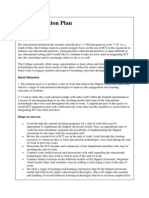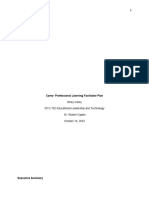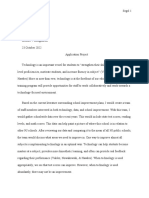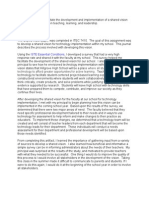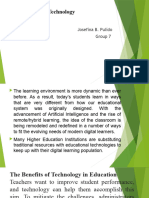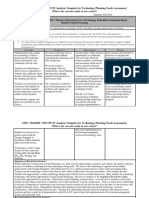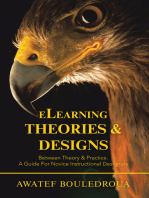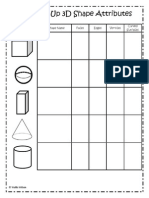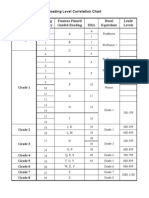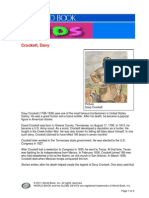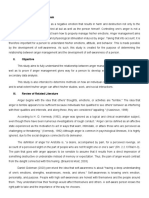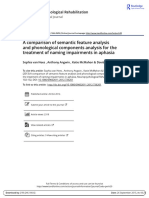Capstone Proposal
Capstone Proposal
Uploaded by
rachelrtreeCopyright:
Available Formats
Capstone Proposal
Capstone Proposal
Uploaded by
rachelrtreeOriginal Description:
Copyright
Available Formats
Share this document
Did you find this document useful?
Is this content inappropriate?
Copyright:
Available Formats
Capstone Proposal
Capstone Proposal
Uploaded by
rachelrtreeCopyright:
Available Formats
Rachel Rountree March 17, 2012 Dr.
Jo Williamson Spring 2011 Making Time for Technology
Setting This Capstone project will involve creating Time for Technology, a professional development opportunity in which teachers will meet once a month to create, plan and share technology. This will be in the form of an informal meeting, to begin with. My role will be facilitator throughout this whole process, I will be there at each meeting to assist those in need, but I also will be finding new teachers who have a gift in a specific technology or internet tool that can share with the staff. At the beginning of the process, I know that I will be more involved in this professional development, however I expect my role to change as the year progresses, so that it becomes a more collaborative exchange. This is a process which I hope that in the future will become a permanent fixture of our professional development. The ultimate goal is that this will be a time that the teachers can use to dedicate to technology, and that in turn it will increase the amount of technology use in the classroom. This is a voluntary meeting, but it will be supported by the administration and it will be suggested that at least one teacher from each grade level attend so they can bring what they have learned back to their team.
Capstone Problem and Rationale
The problem that I have noticed at our school is that there is a lack of professional development available to the teachers when it comes to technology. According to Rodriguez, Schools should provide teachers with abundant opportunities to become fluent in using technology to bolster instruction and help students develop higher-order thinking and problem-solving skills (Rodriguez, 2000). This is something that Timber
Ridge is missing. We are very fortunate to be a high achieving school, so in our School Strategic Plan we are not focused on increasing test scores, instead, we are working to increase higher-order thinking skills. Rodriguez points out that teachers need to become fluent in using technology to improve their instruction which will help students achieve those higher-order thinking skills. The current professional developments for teachers are more instruction based and no (or very little) technology is involved. When there is professional development for technology, it is usually one day, and the teachers are expected to go back and begin using the technology immediately. What is happening at Timber Ridge, is that many teachers are getting excited about using the technology, but without the ongoing professional development, teachers are putting away the new technology that they are using and going back to what they are used to using. This can be changed. With ongoing technology training opportunities, teachers can see the value of using technology in their classroom as well as have time to create lessons using technology for their students. The following quote supports my statement that we need to have ongoing training for technology, Professional development takes time and must be conducted over several years for significant change in educational practices to take place. Substantial change in school practice typically takes four to seven years, and in some cases longer" (Rodriguez, 2000). When I did a survey of the teachers at my school, and from conversations I have had with the teachers, many stated that there wasnt enough training or professional development for technology. They agreed that if there were more opportunities for technology professional development, that they would
feel more comfortable with technology and use it frequently. The purpose of this Capstone is to meet the current needs of the teachers at my school by providing time each month that will be dedicated to technology. The technology meetings will be a combination of professional development on a specific technology and time to collaborate and create activities and lessons for their classroom. I hear all the time that there is not enough time for creating with technology, so although I cannot add any more hours in a day, I can dedicate an hour a month to technology for them.
Objectives and Deliverables My objectives for this Capstone project are to: Have more teachers and students using technology for instruction every day. We will know that this is happening by the learning walk data collected by the administration. Currently 42% of teachers are using technology, and we would like to increase that! More student centered activities using technology (having the students create using technology- higher level thinking skills). We can measure this by sending out teacher surveys at the beginning and end of the capstone project to determine if there has been an increase in student-centered activities using technology. Increase teacher comfort and ease of use with technology. Again, a teacher survey will be used to determine teacher comfort with technology before and after the capstone project. Create ongoing, collaborative learning with technology. This will be more of an observable trait, and we can use training attendance records to see how many teachers are continuing to come to learn about technology. Establish a variety of technology use, not only using the SmartBoard, but teachers and students will use a variety of technologies for instruction. This can be determined by a teacher survey given at the beginning and end of the capstone project to determine how many new technologies our teachers are using with their students.
My Deliverables for this project will be: An increased use of technology in the classroom, where we have technology use happening more than 60% of the time in any given classroom. More student-centered technology , more students producing work using technology. Have student samples of Prezis, Wordles, SmartBoard activities created by students. Teachers becoming more comfortable with technology. Having teachers create Prezis, Wordles, and SmartBoard activities for their students. Student data collected showing higher levels of thinking being accomplished by using technology.
PSC Standards Standard 5 Professional Learning and Program Evaluation o 5.1 Needs Assessment - candidates conduct needs assessments to determine school-wide, faculty, grade-level, and subject area strengths and weaknesses to inform the content and delivery of technology-based professional learning programs. o 5.2 Professional Learning - candidates develop and implement technology-based professional learning that aligns to state and national professional learning standards, integrates technology to support face-toface and online components, models principles of adult learning, and promotes best practices in teaching, learning, and assessment. o 5.3 Program Evaluation - candidates design and implement program evaluations to determine the overall effectiveness of professional learning on deepening teacher content knowledge, improving teacher pedagogical skills and/or increasing student learning.
Product Description
a) For my Capstone project, I will be developing an ongoing professional learning for technology in my school. I intend on creating a monthly training for technology that we will have access to at our school. Some days we will have trainings on a specific technology, focusing on how it can be used in the classroom to help our students reach their higher level thinking skills, which is our school goal. The other days will be dedicated to collaboration and creating with technology. These
will be informal trainings, since the needs of each teacher at the trainings may change. However, I will have a topic to introduce and train the teachers on, every other month. In order to meet the needs of the teachers at Timber Ridge, I do not want to overburden them, and from teacher interviews, many feel as though they do not have enough time to develop activities or lessons with technology. This project will give teachers that time to develop their activities with technology. Teachers need large blocks of time to gain initial familiarity with new hardware or software, learning and practicing for sustained periods (Rodriguez, 2000), I am hoping with this capstone project, we can begin finding time to gain familiarity with the technology or internet tool, so teachers will be more likely to use it. What is important to this capstone, is that the teachers are working together, Educators must develop their collective capacity to function as PLCsCapacity building is not just for workshops and professional development for all. It is the daily habit of working together, and you cant learn this from a workshop or course. You need to learn by doing it, and having mechanisms for getting better at it on purpose (DuFour, DuFour, Eaker & Many, 2006). The quote by DuFour et al, helps to solidify the importance in working in a collaborative state, which is what I strive for in this capstone project. In Whatever It Takes by DuFour et al, he states, People who engage in collaborative team learning are able to learn from one another and thus create momentum to fuel continued improvement. (DuFour, DuFour, Eaker & Karhanek, 2004). This is a very powerful quote about collaboration, and I plan to remember it while carrying out this Capstone Project. I strongly believe in collaboration, and hope, as my objective state to make this
an ongoing, collaborative learning with technology. My Role in this project will be an organizer and facilitator. I will plan out every other meeting for there to be training on a specific technology; however I will not be the one in charge each week. I will draw on the expertise of the teachers in my school, and give them the opportunity to lead the group and share what they know, and to help build a sense of collaboration among teachers to fuel continued improvement. Funding for this project is tricky, due to the economy the way it is, we do not have money to spend on this professional development. However, since it focuses on collaboration and we will be drawing on the knowledge of our fellow teachers, we do not need to spend money for this Capstone. However, being fortunate to be at a school with a foundation, if we come across a need to purchase software for our students as a result of this professional development we can write a grant for the software. Our Foundation has a special interest in technology, and a between 50%-75% of their money is spent on technology, depending on the year.
I will use several resources in preparing my technology related professional development. There are many resources available online that I can use, as well as many texts and literature that have been loaned to me from my Principal, who is supportive of this endeavor. The books that I have to refer to are; Finding Time for Professional Learning by Valerie von Frank (von Frank, 2008), Whatever It Takes: How Professional Learning Communities Respond When Kids Dont Learn by Richard DuFour et al (DuFour, DuFour, Eaker & Karhanek, 2004), School Administrators Staff Development Activities Manual by Ronald T. Hyman
(Hyman, 1986), and Learning by Doing by Richard DuFour et al (DuFour, DuFour, Eaker & Many, 2006). One of the websites that I have already accessed on technology and professional development is Critical Issue: Providing Professional Development for Effective Technology Use written by Ginger Rodriguez (Rodriguez, 2000). This website is specifically tailored to professional development involving technology, and addresses many of the issues that I may encounter while developing these professional development opportunities for my school. Another great internet site for reference in professional development and technology is Strategies, Solutions, and Innovations for Technology Leaders by David Jakes (Jakes,2004). The books that I have tell me how to move forward with my professional development plan, and the websites will supplement the books by narrowing it down to professional development with technology.
b) Timeline
Jan. 2012 Meet with Principal to go over timeline for Capstone
Feb. 2012 Plan format of Professional Development
March 2012 Come up with specific goals for each monthly meeting
April 2012 Acquire teacher volunteers to lead or assist in leading specific training.
May 2012 Meet with Principal to finalize professional development plan for the upcoming school year
Aug. 2012 First Monthly meetingIRespond
Sept. 2012 Second Monthly meetingcollaboration time
Oct. 2012 Third Monthly meetingSmartBoard
Nov. 2012 Fourth Monthly meetingCollaboration time
Dec. 2012 Fifth monthly meeting Internet tools
We will continue our meetings into 2013, with alternating topics and collaboration time with technology.
c) Resources: A classroom to hold each training/meeting Teacher laptops (each teacher will need to bring theirs- lap top carts are available if a teacher forgets) Teacher trainers- I will be using teachers at my school that are skilled in specific technologies to lead or assist me with trainings Access to the technologies that we will be training on
Evaluation Plan a) There are several ways that I plan on using to determine if I have met my objectives for this project. One way I will use to determine how many teachers are attending these meetings. I am not requiring all teachers to attend because many are in graduate school, or work the After School Program, or tutor after school, so it may be difficult to require all teachers to attend. But if there are many teachers attending each month, then I will know that the teachers are enjoying the technology trainings, which will tell me if I was successful in meeting my objective of establishing an ongoing, collaborative learning environment. I will also send out a survey to the staff as a follow up survey to one I sent earlier this year, one at the beginning of the year, and one at the end. The survey will have the same questions, and the original survey, and I will be looking to see how the teachers have changed what they use technology for, are they using it for more student-centered activities, like our goal is. I will also use the data from the learning walks that the administration does to see if technology use has increased in each classroom. Another objective to this process was to have more students and teachers using technology, the data from the learning walks will give me the information about how much time are we spending with technology. I will also being using a rubric on Professional Development prior to beginning my professional development meetings to ensure that I have created an effective professional development plan for the staff at my school. The PD rubric can be found at: http://school.discoveryeducation.com/schrockguide/assess.html.
b) Jan. 2012 Send out survey for teachers to complete on how comfortable they are with using technology. Aug. 2012 Prior to first meeting, review professional development Oct. 2012 Check teacher attendance- this will be our third meeting. Nov. 2012 Meet with administration to go over walk through data from Augcurrent, to monitor increase of technology use in the classrooms Dec. 2012 Send out Second survey on teacher comfort with technology
c) Samples: Professional Development Rubric: (Press control and click on document to open in new window- for better viewing)
Survey for teachers to complete: (Control and click on screen shot for link to the complete survey)
Walk through data: Based on the data that the administration has taken currently, 40% of the students are using technology in their classrooms at the time they are doing their data walks. Below is a timeline of where I would like that data to be each month. Month % of technology use Aug. 2012 45% Sept. 2012 50% Oct. 2012 55% Nov. 2012 60% Dec. 2012 65%
Part A References
Rodriguez, G. (2000). [Web log message]. Retrieved from http://www.ncrel.org/sdrs/areas/issues/methods/technlgy/te1000.htm DuFour, R., DuFour, R., Eaker, R., & Many, T. (2006).Learning by doing. Bloomington, IN : Solution Tree. Hyman, R. (1986). School administrators staff development activities manual. Paramus, NJ: Prentice Hall. DuFour, R., DuFour, R., Eaker, R., & Karhanek, G. (2004). Whatever it takes: how professional learning communities respond when kids don't learn. Bloomington, IN : Solution Tree. von Frank, V. (2008). Finding time for professional learning. Oxford, OH: Mational Staff Development Council. Jakes, D. (2004, April 24). [Web log message]. Retrieved from http://www.techlearning.com/techlearning/pdf/events/techforum/chi04/vault/1/Ja es_Presentation2.pdf
You might also like
- Connected Leader - Module 1Document22 pagesConnected Leader - Module 1api-670274155No ratings yet
- Reading Recovery Level Book ListsDocument31 pagesReading Recovery Level Book ListsrachelrtreeNo ratings yet
- John Henry ClozeDocument1 pageJohn Henry Clozerachelrtree0% (1)
- Paul Bunyan ClozeDocument1 pagePaul Bunyan ClozerachelrtreeNo ratings yet
- Nestle 6 Stage Pricing & Communication StrategyDocument4 pagesNestle 6 Stage Pricing & Communication StrategyShreyansi SinghalNo ratings yet
- Emt501 Task 1 Action PlanDocument5 pagesEmt501 Task 1 Action Planapi-238497149No ratings yet
- Shared Vision RationaleDocument10 pagesShared Vision Rationaleapi-321269218No ratings yet
- Brewer 1Document2 pagesBrewer 1api-508724587No ratings yet
- Running Head: Technology Integration Plan 1Document12 pagesRunning Head: Technology Integration Plan 1api-301971398No ratings yet
- MpreptechintegrationplanDocument9 pagesMpreptechintegrationplanapi-290153267No ratings yet
- Conditions Synthesis ReportDocument5 pagesConditions Synthesis Reportapi-286042559No ratings yet
- TerrynarrativeDocument8 pagesTerrynarrativeapi-271074262No ratings yet
- About The DistrictDocument11 pagesAbout The Districtapi-310885944No ratings yet
- Edld 5352 Week 4 PlanDocument4 pagesEdld 5352 Week 4 PlanCole SandersNo ratings yet
- Technology Action PlanDocument4 pagesTechnology Action PlanCole SandersNo ratings yet
- Digital Learning Inside ClassroomDocument7 pagesDigital Learning Inside ClassroomJOHN RUBIE INSIGNENo ratings yet
- Individual Project Definition - KchinnDocument8 pagesIndividual Project Definition - Kchinnapi-377159548No ratings yet
- Cmbajak NeedsassessmentDocument9 pagesCmbajak Needsassessmentapi-340715459No ratings yet
- Professional Development PlanDocument4 pagesProfessional Development Planapi-245941312No ratings yet
- Swot TorisincoDocument15 pagesSwot Torisincoapi-324301183No ratings yet
- Carey - Professional Learning Facilitator Plan 1Document10 pagesCarey - Professional Learning Facilitator Plan 1api-702696315No ratings yet
- Settles Carrie SWOT Template RevisedDocument14 pagesSettles Carrie SWOT Template Revisedcsettles1No ratings yet
- Module 7 Application ProjectDocument4 pagesModule 7 Application ProjectJNo ratings yet
- What Is Instructional TechnologyDocument3 pagesWhat Is Instructional TechnologyMousum Kabir100% (3)
- Et 680 Technology Planning PaperDocument11 pagesEt 680 Technology Planning Paperapi-542331823No ratings yet
- ISTE National Educational Technology Standards For Students (NETSFS)Document23 pagesISTE National Educational Technology Standards For Students (NETSFS)Shairon palmaNo ratings yet
- Futch-Technology Planning Paper 2Document13 pagesFutch-Technology Planning Paper 2api-298384405No ratings yet
- Professional Learning 2011 Tech IntDocument5 pagesProfessional Learning 2011 Tech Intmalcolm1911No ratings yet
- Chinn Needs AssessmentDocument6 pagesChinn Needs Assessmentapi-377159548No ratings yet
- Standard 1Document3 pagesStandard 1api-368727465No ratings yet
- Ipads For Learning Getting StartedDocument41 pagesIpads For Learning Getting StartedSoraya QuirinoNo ratings yet
- Gennuso Professional Learning Facilitator PlanDocument13 pagesGennuso Professional Learning Facilitator Planapi-550159336No ratings yet
- Technology Planning PaperDocument19 pagesTechnology Planning PaperAmanda KazinNo ratings yet
- Standard 3 6 Kathleen fv61Document2 pagesStandard 3 6 Kathleen fv61api-259153386No ratings yet
- Alfonso Amy Reflection Standard5.2Document3 pagesAlfonso Amy Reflection Standard5.2ah2maxNo ratings yet
- 1 1 WishonDocument2 pages1 1 Wishonapi-259399200No ratings yet
- Professional Learning Facilitator PlanDocument10 pagesProfessional Learning Facilitator Planapi-659487474No ratings yet
- STD 1Document3 pagesSTD 1api-405559723No ratings yet
- Technology IntegrationDocument9 pagesTechnology IntegrationAdonijah OgonyNo ratings yet
- Curran - Swot AnalysisDocument6 pagesCurran - Swot Analysisapi-216963445No ratings yet
- Educ 5324-Technology Plan Template 2Document8 pagesEduc 5324-Technology Plan Template 2api-340945831No ratings yet
- Focus On SkillsDocument16 pagesFocus On Skillsapi-240073881No ratings yet
- Alfonso Amy Capstone PartBDocument9 pagesAlfonso Amy Capstone PartBah2maxNo ratings yet
- Educ-205 Chapter6Document12 pagesEduc-205 Chapter6Marita TabuzoNo ratings yet
- 214 Final ProjectDocument8 pages214 Final Projectapi-466394531No ratings yet
- WK8Assign Arnold JDocument19 pagesWK8Assign Arnold JJessica LeighNo ratings yet
- ITEC 7410/EDL 7105 SWOT Analysis Template For Technology Planning Needs AssessmentDocument19 pagesITEC 7410/EDL 7105 SWOT Analysis Template For Technology Planning Needs Assessmentapi-405747505No ratings yet
- Technology Improvement PlanDocument7 pagesTechnology Improvement Planapi-435904635No ratings yet
- Activity No 8Document4 pagesActivity No 8Mark James Omas-asNo ratings yet
- Effective Use of TechnologyDocument27 pagesEffective Use of TechnologyBIBOY VLAGADAGSNo ratings yet
- Literature Review of Assessing Student LearningDocument8 pagesLiterature Review of Assessing Student Learningapi-283267030No ratings yet
- Conrad DTTPDocument16 pagesConrad DTTPBeckyConradNo ratings yet
- Supplementary LecturesDocument13 pagesSupplementary LecturesMarc Anthony ManzanoNo ratings yet
- Memo To SuperintendentDocument3 pagesMemo To Superintendentpuppeted85No ratings yet
- Groover L Swot AnalysisDocument20 pagesGroover L Swot Analysisapi-412091880No ratings yet
- C Parker Capstone Partb PartcDocument8 pagesC Parker Capstone Partb Partcapi-651485779No ratings yet
- Digital Learning & Teaching Coaching Roadmap - : ECI519 SP2015Document20 pagesDigital Learning & Teaching Coaching Roadmap - : ECI519 SP2015api-284638910No ratings yet
- CraycraftrationalepaperfinalDocument22 pagesCraycraftrationalepaperfinalapi-235540372No ratings yet
- Trant SharedvisionDocument7 pagesTrant Sharedvisionapi-320990006No ratings yet
- M Ryall Swot AnalysisDocument18 pagesM Ryall Swot Analysisapi-259585577No ratings yet
- Kayla Washington EDTC 640 Education Technology Reflection Essay September 15, 14Document6 pagesKayla Washington EDTC 640 Education Technology Reflection Essay September 15, 14api-310885944No ratings yet
- Benchmark-Reflection of Professional Development SessionDocument7 pagesBenchmark-Reflection of Professional Development Sessionapi-520679261No ratings yet
- BlogsDocument3 pagesBlogsapi-259387750No ratings yet
- Elearning Theories & Designs: Between Theory & Practice. a Guide for Novice Instructional DesignersFrom EverandElearning Theories & Designs: Between Theory & Practice. a Guide for Novice Instructional DesignersNo ratings yet
- Hawkeye 4Bs Poster 2Document1 pageHawkeye 4Bs Poster 2rachelrtreeNo ratings yet
- SOAR Calendar NovDocument1 pageSOAR Calendar NovrachelrtreeNo ratings yet
- 3 D Shape AttributesDocument1 page3 D Shape AttributesrachelrtreeNo ratings yet
- Count by 5 HandDocument2 pagesCount by 5 HandrachelrtreeNo ratings yet
- Bossy RDocument1 pageBossy RrachelrtreeNo ratings yet
- Class Dojo Points!: Green Day-0 and MORE PointsDocument1 pageClass Dojo Points!: Green Day-0 and MORE PointsrachelrtreeNo ratings yet
- Grade 1 Unit 1 Parent LetterDocument2 pagesGrade 1 Unit 1 Parent LetterrachelrtreeNo ratings yet
- Comparing Number HeartsDocument5 pagesComparing Number HeartsrachelrtreeNo ratings yet
- Ms. Rountree's Reading LogDocument2 pagesMs. Rountree's Reading LograchelrtreeNo ratings yet
- Determine Pre-: Anchor Chart:Prefixes and Their RootsDocument4 pagesDetermine Pre-: Anchor Chart:Prefixes and Their RootsrachelrtreeNo ratings yet
- 3d Shape HomeworkDocument1 page3d Shape HomeworkrachelrtreeNo ratings yet
- Pronoun PracticeDocument4 pagesPronoun PracticerachelrtreeNo ratings yet
- George Washington Carver WritingDocument1 pageGeorge Washington Carver WritingrachelrtreeNo ratings yet
- Compound Word SleuthDocument2 pagesCompound Word SleuthrachelrtreeNo ratings yet
- Contraction ManiaDocument2 pagesContraction ManiarachelrtreeNo ratings yet
- Capstone Log: Date Activity/Amount of Time PSC Standards HoursDocument3 pagesCapstone Log: Date Activity/Amount of Time PSC Standards HoursrachelrtreeNo ratings yet
- I Can Statements For ParentsDocument12 pagesI Can Statements For ParentsrachelrtreeNo ratings yet
- Reading Level ChartDocument1 pageReading Level ChartrachelrtreeNo ratings yet
- Math VocabDocument24 pagesMath VocabrachelrtreeNo ratings yet
- Narrative Writing ChecklistDocument1 pageNarrative Writing Checklistrachelrtree100% (1)
- 2nd 9 WeeksDocument1 page2nd 9 WeeksrachelrtreeNo ratings yet
- How Can I Use Glogster in My Own ClassroomDocument1 pageHow Can I Use Glogster in My Own ClassroomrachelrtreeNo ratings yet
- Annie OakleyDocument1 pageAnnie OakleyrachelrtreeNo ratings yet
- John HenryDocument1 pageJohn HenryrachelrtreeNo ratings yet
- Davy CrockettDocument2 pagesDavy CrockettrachelrtreeNo ratings yet
- Comparative Study Discussing The Difference Between Early Development of Child While Having Working Mother (Nurses and Other Profession)Document61 pagesComparative Study Discussing The Difference Between Early Development of Child While Having Working Mother (Nurses and Other Profession)Syeda KhizraNo ratings yet
- Pangasinan State University COLLEGE OFDocument10 pagesPangasinan State University COLLEGE OFAyessa Joy GarciaNo ratings yet
- Unit 1: Genius: Nature or Nurture?Document17 pagesUnit 1: Genius: Nature or Nurture?luis carlos principe martinezNo ratings yet
- CRV. Controlled Remote Viewing by Daz SmithDocument170 pagesCRV. Controlled Remote Viewing by Daz SmithṨĸṳlḷ Kȉď85% (13)
- Sotta!Document4 pagesSotta!api-3711271No ratings yet
- I. Statement of The ProblemDocument10 pagesI. Statement of The ProblemLJ FamatiganNo ratings yet
- The Relationship Between Growth Mindset and Students' Psychological Well-BeingDocument52 pagesThe Relationship Between Growth Mindset and Students' Psychological Well-BeingKathleen GelsanaNo ratings yet
- Question Text: The Quality of Goodness or Badness in A Human Act IsanswerDocument23 pagesQuestion Text: The Quality of Goodness or Badness in A Human Act IsanswerJohn Michael Cañero MaonNo ratings yet
- Types of Fallacies and BiasDocument7 pagesTypes of Fallacies and Biastravisagpasa123No ratings yet
- GRADE 12 VISION 2025 Term 2 Project 2020Document3 pagesGRADE 12 VISION 2025 Term 2 Project 2020marcNo ratings yet
- Developing Speaking Skills in The ClassroomDocument36 pagesDeveloping Speaking Skills in The ClassroomFernanda Valiente IngaNo ratings yet
- Computing DiscountsDocument11 pagesComputing Discountssayer_nicoleNo ratings yet
- GROUPWORKDocument2 pagesGROUPWORKCatherine SamsonNo ratings yet
- Chapter 1Document33 pagesChapter 1CharleneKronstedtNo ratings yet
- Participatory Visual and Digital Methods by Aline Gubrium and Krista HarperDocument3 pagesParticipatory Visual and Digital Methods by Aline Gubrium and Krista HarperkenNo ratings yet
- Oral Communication C Declamation and TalkDocument5 pagesOral Communication C Declamation and TalkPaula SalvosaNo ratings yet
- Aspiring For LeadershipDocument16 pagesAspiring For Leadershipudaya_1990No ratings yet
- Humphrey 2011 PDFDocument5 pagesHumphrey 2011 PDFŁinzZè KrasniqiNo ratings yet
- Theatre Syllabus - CBSEDocument19 pagesTheatre Syllabus - CBSEAkshat Arora100% (1)
- Assessment TasksDocument2 pagesAssessment TasksAurea Jasmine DacuycuyNo ratings yet
- Shifter Accountancy Working Student Self Efficacy and Their Academic PerformanceDocument50 pagesShifter Accountancy Working Student Self Efficacy and Their Academic Performanceanale candameNo ratings yet
- Steps To Increase Intelligence FromDocument3 pagesSteps To Increase Intelligence Fromjoão Rodrigues Correia RamosNo ratings yet
- MathDocument71 pagesMathDayondon, AprilNo ratings yet
- A Comparison of Semantic Feature Analysis and Phonological Components Analysis For The Treatment of Naming Impairments in AphasiaDocument32 pagesA Comparison of Semantic Feature Analysis and Phonological Components Analysis For The Treatment of Naming Impairments in AphasiaMaca Martínez-CuitiñoNo ratings yet
- Final Review For CBDocument9 pagesFinal Review For CBMinh ThưNo ratings yet
- Proximate Analysis of FoodDocument13 pagesProximate Analysis of FoodAbhishek KumarNo ratings yet
- ASE Tudy EmplateDocument2 pagesASE Tudy EmplateAngelo OdalNo ratings yet
- Authentic News Item Text For Improving Students' Ability in Finding Main IdeaDocument10 pagesAuthentic News Item Text For Improving Students' Ability in Finding Main IdeaMuh Abid ArrohmanNo ratings yet
- 7-Fidelity-Hgp-Q1-Module - 2Document2 pages7-Fidelity-Hgp-Q1-Module - 2Mark SolivaNo ratings yet





